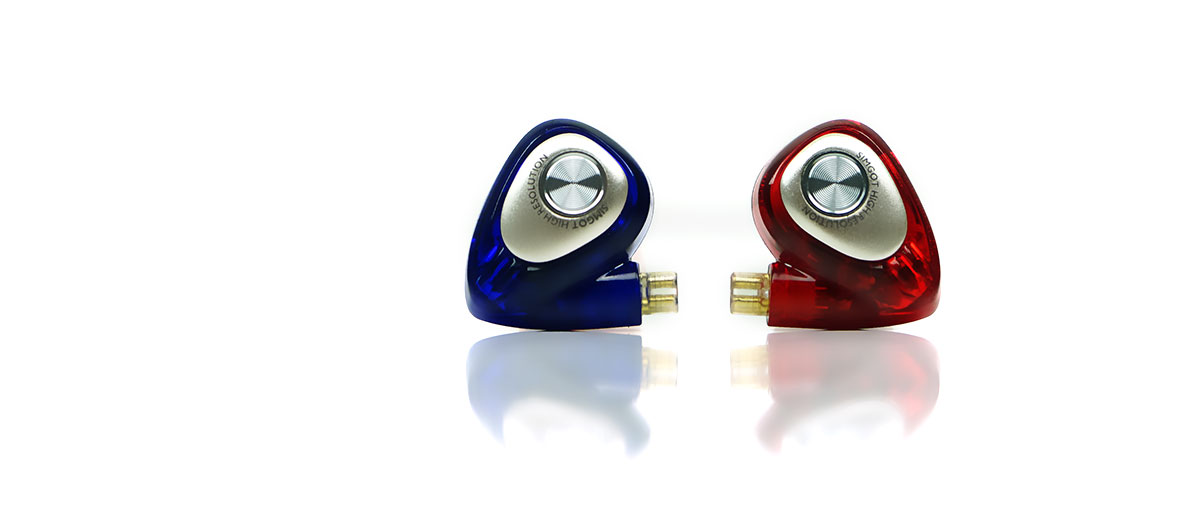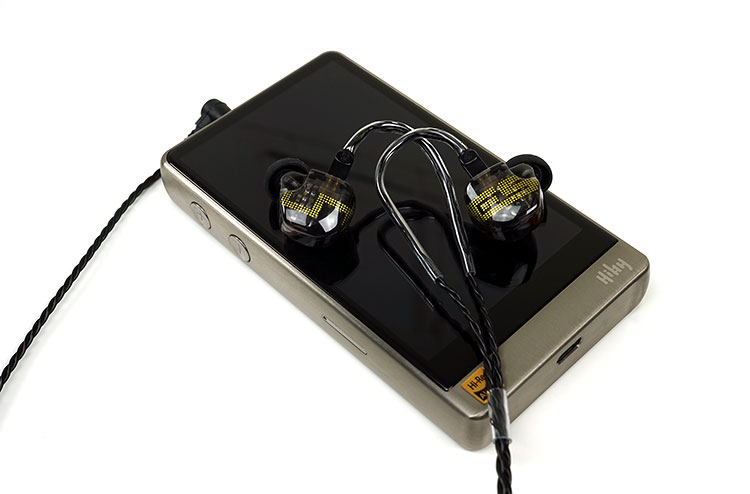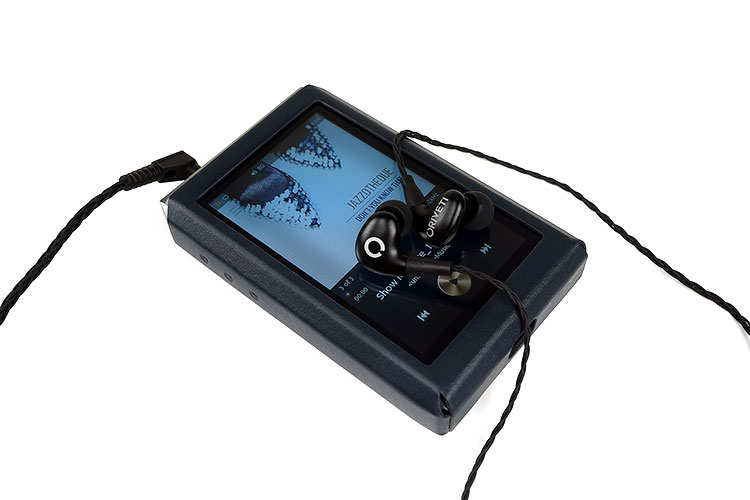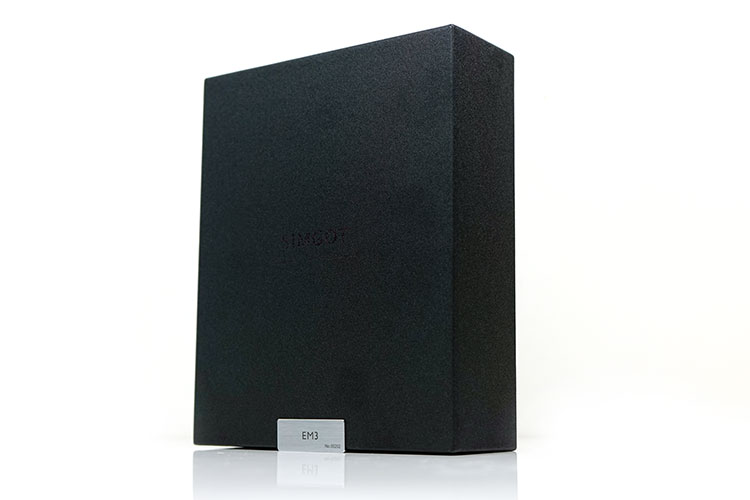Sound Impressions
Tonality & Presentation
The EM3 is not quite V-shaped. I would class it close to a loose sounding W-shaped response curve with a greater emphasis on its low-end. It is more neutral to bright in its tonality than the EN700 Pro and has a fair degree more clarity and detail beyond 2k whereas the EN700 Pro rolls off a bit more.
The coloration is definitely on the musical side with an emphasized sub-bass and upper mids presence but its single DD is actually quite tight and balanced sounding. It does have a natural dynamic driver sound but it is not coated in molasses and struggling to keep up and does add some pleasing depth to the EM3 sound.
Staging
The staging on the EM3 has fairly good depth and height, however, there is a noticeable dip in the lower mids from 500Hz to 1k and a spike in the upper mids from 1k onwards. Depending on the pitch of the vocals the EM3 can sound intimate or a touch thinned out and recessed.
Female vocals or higher pitched voicing will bring a more intimate feel to the EM3 staging whereas lower-pitched voicing and instruments will sit further back in deference to a peppier upper midrange percussion presence. Besides from sitting further back the leaner note will sound clean, relatively well separated and fairly accurate in terms of placement.
Bass
I do like the dynamic driver SIMGOT have used for the EM3. I enjoyed it on the EN700 Pro and found it fairly well balanced rather than overpowering. The extension is excellent, the pace is above average and the level of decay, whilst slower than a BA, is not that slow.
The EM3 low-end is sub-bass biased with a fairly sustained 10dB elevation over its lower mids up to around 100Hz before dipping quite quickly to around 1k. This is not a ‘suck out’ for me, it is not terribly disjointed in that manner. However, the effect is a cooler leaner instrumental timbre even if the sub-bass presence and power are quite good. The EM3 thus relies a lot on its sub-bass performance for power rather than mid-bass elevation for warmth and body.
I tend to find this bass tuning to work far more effectively for the likes of Synth Wave and House where it relies on a cooler tone and deeper sub-bass rhythm. Genres such as mid-paced classic rock where more mid-bass warmth and a meatier timbre in the lower midrange tend to sound more at home with the EN700 Pro.
Mids
The EM3 is fairly recessed in the lower midrange which thins out instrumental timbre a little. The accentuated sub-bass presence up to around 80Hz does add an appreciable level of power so it doesn’t lack in depth what it lacks in body. The upper mids are actually quite far forward and on a level plateau with the lower treble before it starts to drop away around 8k. Beyond that, it has some energy but not a typically V-Shaped spiked with too much sharp partial overtones.
Female vocal presence is the main benefactor here being forward and intimate rather than dipped or recessed to the point of being veiled. Male vocals are a bit thinner and further back, particularly any voicing below 1k. You get all sorts of recessed mids these days with some opting to mute the 2-4k range which I personally dislike. Not so with the EM3, it keeps them front and center with a lively percussion presence infused with a clean timbre that stops short of being harsh.
Treble
I had actually approached the EM3 treble performance with a degree of trepidation given the FiiO F9 uses the same dual TFWK drivers. However, the EM3 is much better tuned than FiiO’s entry-level hybrids with a much more coherent performance if still a little north of neutral. I would advise the Eartips II over Eartips I, however. Tips 2 have a smoother top end compared to the more energetic tips I.
Whilst the majority of the top-end is forward sounding it is nowhere near as spikey as uneven sounding as the F9 and a touch smoother than the F9 Pro. In fact, if anything, around the 5-7k marker the EM3 has a little less energy which prevents clean percussion passages from becoming splashy percussion passages and vocal harmonics becoming too sharp and unbalanced sounding. Upper treble has decent extension also up to around 8k and a gentle nudge beyond into 10-12k for some welcome air and sparkle.
Matchability
Efficiency
There is scant detail on the ohm and sensitivity ratings but after comparing it to similar hybrids we came to a conclusion that it is roughly 16-20Ω and about 101-14dB max. Thus, I would classify the SIMGOT EM3 as a medium efficiency IEM. It will play fine from most sources if not all including smartphones but you will have to push the volume up a touch higher, perhaps 4-5dB higher than some competing hybrids. The only one that measured close was the F9 Pro in terms of volume matching.
Noise
Noise is not an issue with the EM3. I could not detect anything on sources with higher than normal noise floors such as the FiiO X3ii and X5iii. It was also dead quiet on both the DX200 with Amp 1 and the DX150 with Amp 6 cards. One other side note, the HiBy Music’s R6 10Ω output impedance did not skew the low-z of the EM3 to any noticeable level so it is a decent pairing also.
Synergy
Firstly, on the tips, my own choice was Eartips II for the enhanced bass warmth and smoother top-end. I can trade a little “clarity” on the treble for something a bit less strident. The same went for DAP pairing, a preference for a natural or warm sounding DAP over neutral sources. Out went the X5iii also, I just didn’t like that slight metallic tinge it delivers to the lower treble and upper mids with the already forward sounding mids of the EM3.
My own personal preferences were Amp 6 and the DX150, the AK100 MK2 and the HiBy Music R6. The R6 will give you a more linear tone if you keep the Mage 8 Ball DSP turned off and the AK100 MK2 is surprisingly organic and excellent for vocals paired with the EM3. The DX150/AMP 6 added some additional warmth to the EM3 timbre and a punchier low-end.
Select Comparisons
Fidue A85
$399
Technical
The first of our triple hybrid comparisons is the A85 “Virgo” which is also a single dynamic and dual BA design. The A85 Virgo is rated at 20Ω and 107dB so its reasonably efficient but will have some scaling capability. The level of sensitivity is rather typical of hybrid IEMs with the dynamic driver usually responsible for pulling down the dB level by a good 5-10 points.
In the case of the SIMGOT EM3 is less efficient than the A85 by a good 4-5dB minimum perhaps more in terms of sensitivity. Considering they use the same driver form the SIMGOT EN700 series, rated, at 101dB I would not be surprised if the EM3 is close to that level. You will find that you have to push the volume up significantly more on DAPs such as the DX150 and DX200 or the AK100 MK2 which were our test DAPs for this review. For example, on both iBasso DAPs, we found the EM3 to sit comfortably at 85 in low gain and 70–75 for the A85.
Performance
The A85 is N-shaped compared to the loose W-Shape of the EM3. This means a more mid-centric presentation with a slow attenuation sub-100Hz and a fairly relaxed top-end which never really peaks and falls away post 7-8k. It does not have a huge amount of odd harmonic presence and somewhere around the 4-6k marker, I can sense a dip that dulls percussion. The tonality is smooth though, sibilant free and even harmonic dominant with a natural to slightly warm instrumental timbre.
The EM3 is much cleaner, brighter with more sub-bass presence and depth as well as a better treble extension, headroom, and air. The EM3 sounds the more powerful and open of the two with the A85 a lot more intimate sounding. Both have a fairly good level of vocal presence, though the EM3 vocals are not quite as rich and full-bodied as the A85. The EM3 is much more dipped in the lower mids which produces a leaner sounding instrumental timbre than the A85.
Genre Preferences
I had mentioned before the EM3’s cleaner sound, good vocal presence and a staging focused on depth and height are more adept with synth wave, dubstep and house and less so with classic rock. The A85’s warmer mid-centric timbre and presence takes that rock route and sounds more at home with the classics such as Zep, Crue and Deep Purple.
Oriveti New Primacy
$299
Technical
The second hybrid, the New Primacy is priced a bit cheaper than the A85 but slightly more than the EM3 at $299. It also uses a single dynamic driver combined with dual BA drivers for the mids and highs. The dynamic driver inside the New Primacy is smaller at 8mm compared to the EM3’s 10mm driver but I am pretty sure both use similar TFWK dual-driver BA’s for the mids and highs.
As with the A85, the New Primacy is significantly more efficient than the EM3. My bet is the smaller dynamic driver used by Oriveti is easier to power and more sensitive than the 10mm used by SIMGOT in the EM3. The New Primacy is rated around 105-107dB and just 8Ω so again my bet is the EM3 is sitting around100-102dB in terms of sensitivity and possibly around 16-20Ω output impedance. Again, volume levels on the tested DAPs were higher on the EM3 by around 10-15 steps (DX200 on low gain) compared to the New Primacy.
Performance
It is all about the dip with these two and where it dips the most. The EM3 dips 500Hz to 1k and the New Primacy dips around 2-5k. This has quite a marked effect on the final presentation. The EM3’s lower mids dip pushes back instrumental positioning, thins it out a touch and produces a cleaner cooler timbre. The New Primacy’s lower mids are more elevated so instrumental timbre is warmer with bit more body and smoother sounding.
The 2-5k dip on the New Primacy, however, dulls the vocals and blunts the percussion timbre even more. It lacks air and excitement with a slight veil compared to the EM3’s more forward sounding upper mids. Male vocals on the Primacy do have better body and presence than the EM3.
The Primacy maybe the more forgiving and smoother of the two, however, the more forward upper mids and lower treble of the EM3 provide a better contrast to their respective sub-bass bias. The EM3 sounds the clearer and airier of the two as a result. The Oriveti also has some energy around 8-10k but it is fairly mild and lacking in sparkle compared to the EM3.
The low-end on both have a bit of sub-bass bias but the bigger dynamic driver of the EM3 has more quantity, slightly better quality, and definitely more power.
FiiO F9 Pro
$139.99
Technical
Our cheapest hybrid in the comparisons to the EM3 and picked primarily because of the use of the same TFWK Knowles dual BA drivers, the 30017s though it does have a slightly smaller 9mm dynamic driver. The F9 Pro is rated at 28Ω and 106db and out of the three compared it is the least efficient and requires more power and a higher level of volume for comfortable listening levels.
The EM3 is much closer to the F9 Pro, perhaps marginally less efficient but maybe around 1-2dB at most. Using an AK100 MKII I rarely felt the need to do large volume adjustments between the two to match, perhaps by 2-3 steps at most.
Performance
The F9 Pro is more of a traditional V-shaped sound signature compared to the W-shaped EM3. Despite the similar drivers being used I find the EM3 much more refined, better tuned and the more forgiving of the two. Both have a raised and impressive low-end response with a sub-bass bias but the F9 Pro is warmer, a bit looser compared to the EM3 performance. There is a tiny bit more roll-off on the F9 Pro sub-bass compared to the larger DD driver in the EM3 which makes a bit of a difference for me.
Both have a recessed lower midrange so instrumental timbre is similar, sounding a bit lean, cooler but fairly well separated with a placement behind higher-pitched vocals. Male vocals on both are a bit leaner sounding though the F9 Pro has a slightly harder tone compared to the smoother EM3.
The big difference really is the upper mids and lower treble. FiiO has tuned the F9 Pro to have a fairly pronounced 7k peak. Now, this is nowhere near as hot as the regular F9 Pro thankfully but it does produce a partial overtone on midrange harmonics that make it the sharper and more sibilant of the two.
SIMGOT have tuned the EM3 a little better with an elevated lower treble but a plateaued one at that. As a result, the EM3 treble is bright and energetic but not as peaky and harsh sounding as the F9 Pro. Thus, for vocals and percussion that draw their upper harmonics from this range, the EM3 is going to sound the more accurate and smoother of the two. That makes a big difference for me personally.
Our Verdict
I honestly had a concern before I reviewed the EM3 that given the same BA drivers were inside the cheaper FiiO F9 Pro that I would get a signature not too far off it. I am happy to say the EM3 tuning and DD driver is more refined and an all-around better performer. It still has that unique look that SIMGOT seems to go for but its more traditional shape fits better and the acrylic body is light with a better seal than the EN700 series.
My only concern is the long-term value proposition with the recently launched FiiO FH5 quad driver coming in at almost $20 cheaper and using higher-end Knowles drivers. Also, the street price of these hybrids can be quite volatile so it remains to be seen if $288 will hold water in 6 month’s time.
As far as the competing triple drivers at the same price point such as the Fidue A85 and New Primacy, I think the EM3 is the better all-around performer. The tuning on the EM3 is just that little more lively and cleaner sounding to my ears.
In terms of genres, the EM3 suites modern dance, synth wave, and R’n’B. It has a stronger low-end presence, better treble extension, and air than the A85. It has a cleaner vocal presence than the Primacy. I would go with the Primacy and A85 for classic rock with their warmer timbre but everything else it is the EM3.
SIMGOT EM3 Technical Specifications
- EM3 adopts the core dynamic driver of EN700 PRO
- Knowles compound dual balanced armature drivers
- Subtle construction system with dual plates and triple frequency divisions
- Modified 0.78mm 2pin detachable connector
- 6N OCC & SPC braided cable











